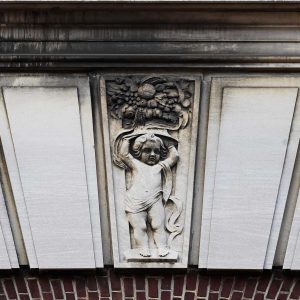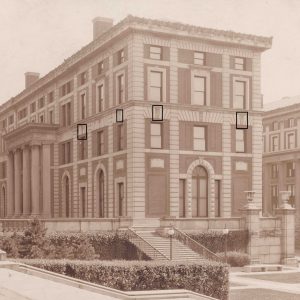Stand in front of Kent Hall and take in the classical design by McKim, Mead and White. Now, take a look above the second story windows. Among the recurring decorative elements, you will find engraved putti or little, chubby cherubs holding garlands and flowers. That’s right: there are “cupids” in front of Kent Hall, the original home of the Law School. In 1910 Trustee John B. Pine found the putti “grotesquely inappropriate.”

Kent Hall opened in October 1910 as the first dedicated home of the Columbia Law School. The building was named after James Kent LLD 1797, the first Professor of Law at Columbia College in 1793. At the dedication ceremony, the Chair of the Board of Trustees George Rives shared his joy in the Law School finally having “an adequate, a commodious and a dignified home.” But not everyone found the new building’s decoration “dignified.”
In the summer of 1910, Chair of the Committee on Buildings and Grounds and Clerk of the Board of Trustees John B. Pine objected to the cupids engraved in the keystones on Kent Hall. He did not find these to be suitable for a law school building. He even claimed that “the carvings on Schermerhorn Hall of fruits and flowers [were] also entirely inappropriate and have been often, and I think, very justly criticized.” In fact, he requested that the architecture firm of McKim, Meade and White submit “detailed drawings of all decorative designs … on a scale large enough to permit examination” before any contracts for Philosophy Hall were awarded.

Charles McKim defended his firm’s design choices. Garlands, festoons, masks, wreaths and children were commonly featured in Roman and Renaissance building ornamentation. These were Italian putti, not cupids. Comparable examples could be found in Raphael’s decorations representing Justice on the ceiling of the Segnatura and in Perugino’s council chamber of the Nobile Collegio del Cambio at Perugia where justice was administered. According to McKim, “[t]he introduction of Putti into the decoration of Kent Hall is amply upheld by the best precedent.”
Perhaps because of this fraught correspondence, which can be found in Central Files Box 528, folder 29, the Trustee Chair Rives felt the need to show some extra support to the architects in his speech: “We owe [Kent Hall’s] physical perfections to the good taste and experience of the University architects, Messrs. McKim, Mead & White.”